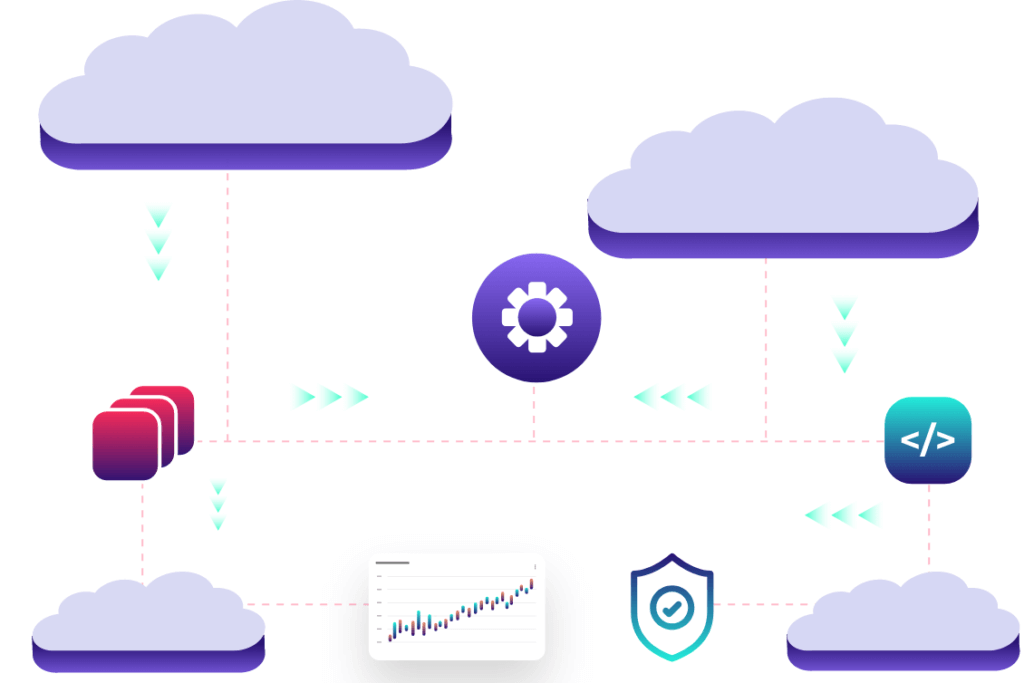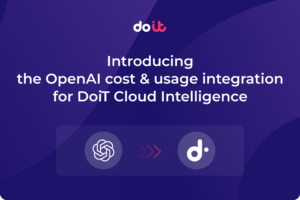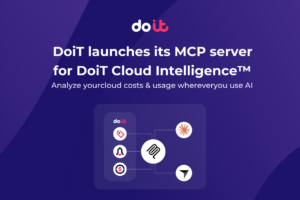How to Choose the Right Cloud Cost Optimization Tools
Optimizing cloud costs isn’t just about saving money. A well-implemented plan includes having a smart strategy for driving innovation and growth. By managing cloud spending effectively, your organization can redirect those cost savings into exciting new projects. That said, cloud computing setups can be tricky, and having the right cloud cost optimization tools makes all the difference.
Understanding cloud cost optimization
Cloud cost optimization is the systematic process of analyzing, controlling, and reducing your cloud spending while maintaining or improving operational performance. But optimization goes far beyond simply cutting costs. The aim is to get the most out of every dollar you spend in the cloud.
Cloud cost optimization can be broken down into two key categories:
- Optimization of resources: Focusing on efficiently managing cloud infrastructure, rightsizing instances, and eliminating waste
- Workload ROI: Evaluating the business value generated by workloads and additional technologies relative to their cloud spend
Successful cloud cost optimization isn’t about just tracking numbers, though. It’s about monitoring key metrics and KPIs that provide actionable insights, including:
- Cost per unit of work: Measuring how much it costs to deliver a specific business outcome (cost per transaction, API call, or user)
- Resource utilization rates: Identifying underutilized resources that may be candidates for rightsizing
- Budget variance: Tracking actual spend against forecasted spend to identify anomalies and prevent overruns
- Cost allocation accuracy: Making sure expenditures are properly attributed to business units, teams, and projects
- Return on cloud investment (ROCI): Evaluating business value generated relative to cloud spend
- Commitment discount coverage: Monitoring what percentage of your workloads is covered by commitment-based discounts
- Idle resource costs: Measuring spending on resources that aren’t actively adding value
- Cost anomalies: Detecting sudden or unexpected changes in spending patterns
Without visibility into these metrics, your organization is operating blindly, which can lead to inefficiencies, waste, and budget overruns. This is where specialized cloud cost management tools come in—they transform complicated data into practical insights.
8 unmatched cloud cost optimization tools

DoiT Cloud Intelligence platform offers a comprehensive suite of tools designed to address the most pressing cloud cost optimization challenges. Let’s explore each solution and the specific problems they solve.
Cloud Analytics
The challenge it solves: Many organizations face challenges in getting a clear picture across multiple cloud providers. Without a unified view, it’s hard to track spending, spot waste, or make smart, data-driven decisions. Finance teams and engineering teams work with different datasets and speak different languages, creating friction that prevents effective cost management.
Cloud Analytics unifies your cost data across Amazon Web Services (AWS), Google Cloud, and Microsoft Azure into a single, intuitive interface. This management solution provides real-time visibility into your multi-cloud spending with powerful visualization and filtering capabilities. It’s worth noting that the FinOps Foundation has rolled out FOCUS (FinOps Open Cost and Usage Specification), which is becoming the industry standard for normalizing cross-cloud costs. However, it still needs significant development work to be implemented effectively.
With DoiT Cloud Analytics, you can:
- Visualize trends across all your cloud providers in a single dashboard
- Drill down into detailed cost breakdowns by service, project, or custom labels
- Compare current spending to historical patterns to identify trends
- Access AI-powered recommendations for cost reduction opportunities
Jelly Button, a mobile gaming company, used DoiT’s cloud analytics expertise to transform its costly analytics pipeline. By implementing a Google Cloud–based solution with BigQuery, Cloud Pub/Sub, Cloud Dataflow, and Google Kubernetes Engine, the company slashed its analytics costs by $240,000 annually—reducing expenses by more than two-thirds while improving reliability.
Anomaly Detection
The challenge it solves: Unexpected cloud cost spikes can devastate budgets and erode profitability. By the time most organizations discover these anomalies through manual reviews or monthly invoices, the damage is already done. Engineering teams often implement new features or services without fully understanding their cost implications, leading to unpleasant surprises.
DoiT’s Anomaly Detection continuously monitors your cloud spending patterns and automatically alerts you to unusual activity before it becomes a significant problem. The system uses machine learning to establish baseline spending patterns and can detect subtle deviations that might indicate waste, misconfigurations, or unexpected resource usage.
Key capabilities include:
- Automated detection of spending anomalies across providers and services
- Real-time alerts via email, Slack, or webhooks
- Customizable sensitivity thresholds to minimize false positives
- Root cause analysis to identify the source of abnormal spending
Tastewise, a GenAI-powered food and beverage analytics platform trusted by brands like PepsiCo and Nestlé, uses Anomaly Detection to catch unexpected cloud cost spikes as they happen. In one instance, the tool alerted the company to unusual CloudTrail spending caused by an accidentally enabled debug flag. Without this early warning, Tastewise would have discovered the issue only at month-end, potentially wasting thousands of dollars.
Attributions
The challenge it solves: In complex organizations with shared cloud resources, accurately allocating costs to specific teams, products, or initiatives is often a manual, error-prone process. This creates accountability gaps where teams have limited visibility into their actual cloud consumption. As a result, it becomes difficult to drive cost-conscious behaviors or make informed decisions about resource allocation.
DoiT’s Attributions provides sophisticated cost allocation, automatically distributing shared cloud infrastructure costs based on actual cloud usage patterns or custom business rules. This solution bridges the gap between finance and engineering by translating technical resource consumption into business-relevant cost metrics.
With DoiT Attributions, you can:
- Create custom allocation rules based on your unique business needs
- Automate the distribution of shared costs across teams or projects
- Generate accurate showback or chargeback reports
- Track cost efficiency metrics for individual teams or products
CattleEye, the world’s first hardware-independent autonomous livestock monitoring platform, used DoiT’s Cloud Analytics Reports and Attributions to gain cost visibility into rapidly growing cloud expenses. By grouping cloud resource costs into “buckets” representing different cost centers (production, dev, data science), the company created a unified dashboard that helped stakeholders understand the actual costs of its work.
Budgeting Alerts
The challenge it solves: Traditional cloud budgeting is rigid and reactive, often leaving teams scrambling to address overspending after it occurs. Setting meaningful budgets requires balancing financial constraints with technical realities—and most organizations lack the tools to proactively manage spending against targets or anticipate potential overruns.
Budgeting alerts enables you to set dynamic, granular spending limits and receive automated alerts when consumption approaches thresholds. This solution provides context-aware monitoring that accounts for normal spending patterns and seasonality.
Key features include:
- Flexible budget creation at any level of your cloud hierarchy
- Progressive alerting at customizable thresholds (e.g., 70%, 85%, 95%)
- Forecast-based alerts that predict potential overruns before they happen
- Integration with workflow tools to automate remediation actions
Bdeo, an AI-powered visual intelligence cloud platform for insurance companies, transformed its approach to cloud spending using DoiT’s cost management tools. Within five minutes, team members can view detailed cost breakdowns by business area and product, helping Bdeo identify hidden expenses like an unnecessary encryption service.
Workload Intelligence

The challenge it solves: Organizations often struggle to balance performance and cost efficiency when sizing cloud resources. Without detailed insights into actual resource consumption patterns, teams tend to over-provision to avoid performance issues, leading to significant waste. Traditional monitoring tools provide metrics but lack actionable recommendations for optimization.
DoiT’s Workload Intelligence analyzes your resource consumption patterns and identifies optimization opportunities based on real-world usage data. This solution goes beyond simple utilization metrics to provide context-aware recommendations that consider performance requirements and usage patterns.
With Workload Intelligence, you can:
- Identify underutilized resources with low-risk rightsizing opportunities
- Receive tailored recommendations for instance types and sizes
- Visualize the impact of potential changes before implementing them
- Monitor the cost-effectiveness of optimizations over time
Cloud orchestration platform Cloudify faced challenges with its engineering-heavy workloads that required significant compute resources. As a growing startup, it needed to optimize costs without committing to long-term reserved instances. Using DoiT’s Flexsave, the company achieved 23% monthly savings on its AWS EC2 costs while giving its developers and customer success managers the freedom to spin up resources on demand without budget concerns.
BigQuery Lens
The challenge it solves: BigQuery costs can spiral unexpectedly due to inefficient queries, suboptimal table designs, or unnecessary data processing. Organizations often lack visibility into which specific queries or datasets are driving costs, making it difficult to optimize spending without potentially disrupting critical analytics workloads.
DoiT’s BigQuery Lens provides deep visibility into your BigQuery usage and costs, with detailed analysis of query performance, storage efficiency, and optimization opportunities. This specialized tool helps you identify the most expensive queries, datasets, and usage patterns so you can target your optimization efforts for maximum impact.
Key capabilities include:
- Detailed breakdown of costs by query, dataset, and user
- Identification of inefficient query patterns and optimization suggestions, such as excessive data scans, frequent full-table scans, unnecessary column selections, and redundant query executions
- Analysis of data storage efficiency and partitioning strategies
- Visualization of usage patterns to help identify peak demand periods
DoiT’s Lens suite also extends beyond BigQuery to include specialized lenses for other platforms including Snowflake, Datadog, Azure, AWS, and GKE. Each lens provides platform-specific analysis while maintaining a consistent approach to cloud cost optimization across an organization’s entire infrastructure.
A mobile games company used BigQuery Lens to identify and optimize its most expensive queries, reducing its monthly BigQuery costs by 50% while maintaining the same analytical capabilities.
Cherre, a commercial real estate data platform, used DoiT’s BigQuery Lens to optimize its complex geospatial data operations. By processing millions of street addresses through Google Maps Platform APIs and analyzing them with BigQuery Geospatial, Cherre tackles the challenging problem of accurately linking buildings with their associated data across disparate sources.
Spot Scaling
The challenge it solves: Balancing cost savings with reliability when using spot instances is a major challenge. Organizations want to leverage the significant discounts offered by spot instances but struggle with the complexity and potential disruption of instance interruptions, especially for production workloads.
Spot scaling automates the management of spot instances, maximizing cost savings while maintaining application reliability.
With DoiT’s Spot Scaling, you can:
- Automatically provision the optimal mix of spot and on-demand instances
- Define reliability thresholds for different workload types
- Seamlessly handle spot instance interruptions without application disruption
- Monitor savings and availability metrics in real time
Flexsave for AWS
The challenge it solves: Managing commitment-based discounts (like Reserved Instances or Savings Plans) requires complex forecasting and ongoing maintenance. Organizations often face a difficult choice: commit to too many reservations and waste money on unused capacity, or commit to too few and miss out on potential savings. The dynamic nature of cloud workloads makes static, long-term commitments particularly challenging.
DoiT’s Flexsave for AWS delivers the benefits of commitment-based discounts without requiring you to make long-term commitments or manage complex reservation portfolios. This solution automatically analyzes your usage patterns and applies commitment-based discounts where they make sense, without any up-front commitment or management overhead.
Key features include:
- Automatic identification of commitment-eligible resources
- Dynamic adjustment of commitment levels based on actual usage
- No up-front financial commitments or long-term obligations
- Guaranteed savings on eligible resources without management overhead
What features are essential for effective cloud cost optimization tools?

When considering cloud cost optimization tools, several key features set the really effective ones apart from basic monitoring tools:
Automated cost allocation
Look for tools that can automatically distribute shared costs based on actual usage or custom business rules. This capability is essential for driving accountability and ensuring accurate financial reporting across teams and projects. Additionally, tools should provide automated recommendations for handling unallocated costs, which remains a significant challenge in multi-cloud environments where resources may lack proper tagging or attribution.
Proactive anomaly detection
Effective tools should use machine learning to establish baseline spending patterns and alert you to unusual activity before it significantly impacts your budget. Customizing alert sensitivity and thresholds is also important to reduce alert fatigue.
Multi-cloud support
As organizations adopt multi-cloud environments, tools that provide unified visibility and consistent optimization capabilities across all major cloud providers become essential for effective management.
The keys to future-proofing your cloud cost strategy
As cloud services continue to evolve and pricing models become more complex, it’s essential to have a forward-looking approach to cost optimization. Here are key strategies to future-proof your cloud cost management:
Embrace FinOps as a discipline
Establish cross-functional collaboration between finance, engineering, and business teams to create a culture of cost insights and shared responsibility. This organizational approach ensures that cost optimization becomes a continuous process rather than a periodic exercise.
Invest in automation
Manual optimization efforts can’t scale with the growing complexity of cloud environments. Prioritize tools that automate routine optimization tasks, from rightsizing recommendations to commitment management, to maintain efficiency as your cloud footprint grows.
Build flexibility into your architecture
Design your cloud architecture to take advantage of evolving pricing models and new service offerings. This includes using containerization to enhance workload portability, implementing infrastructure as code for consistent deployments, and adopting modular designs that can adapt to changing cost dynamics.
Cloud cost optimization with DoiT
Choosing the best cloud cost optimization tools is a decision that impacts not just your IT budget, but your organization’s ability to innovate and grow. The ideal solution provides deep visibility, actionable insights, and automation capabilities that align with your specific business needs.
DoiT’s Cloud Intelligence Platform offers a unique combination of powerful tools, seamless integration, and expert guidance that helps organizations maximize the value of their cloud investments. By addressing the full spectrum of cost optimization challenges—from basic visibility to advanced automation—DoiT enables you to build a sustainable, efficient cloud cost strategy that scales with your business.
Explore DoiT Cloud Intelligence for yourself. Take the interactive, self-guided demo today to see how it can help you reduce costs.


